click to |
Processing Saved Vegetable Brassica Seed is REALLY EASY:
This is a great thing to learn as it's the same for a huge range of vegetable seed.
So a single new skill gives you lots of veg - once you can do this you can keep your own Cabbage, Cauliflowers, Kale, Broccoli, Sprouts, and all the Chinese and Japanese Greens.
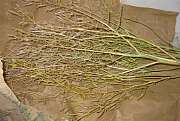
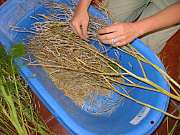
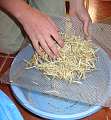

Many of the brassicas (cabbages, cauliflowers etc) love to cross with
each other .
So only let one variety flower each year:
you don't really want to end up with some sort of sprouting-cabbage, or brussels-kale.
But that's ok - the seed (if dried well , and we tell you how) keeps for years and years -
so you simply let only one variety flower each year and not worry about crossing.
You can still grow all the others to eat of course, just don't let them flower.
(Though Sprouting Broccoli can be a pain, so pick regularly, or it will cross with your seedcrop)
How many to save from?
You can't keep seed from just 1 plant because all these sort of vegetable breed as a 'herd'.
You need a minimum of 20 plants to get healthy seed, otherwise they get too inbred and stunted.
Then it's pretty simple: Flower stalks from a good-sized population are hung
up to dry,
then broken open over a bowl (or old baby bath in this case!)
The bits of pod are screened out with a sieve or a soil riddle -
but
you can instead winnow them off in a breeze pretty easily if you prefer.
Processing Your Brassica Seed:
Which plants to save seed from:
Hopefully you've paid attention to this bit earlier on in the year. You need good healthy plants that look and grow like they should. Any small, sickly or misshapen ones? It's very easy to stop them contributing to next years seed - just don't let them flower, and eat them instead. So as you grow the plants, look at them and think - which are particularly good? Which are particularly feeble? Any that are simply wrong?
Maybe mark the ones to keep and allow to flower by marking with a red ribbon or string. Then let only those flower. Snap off any flower shoots from any you are dubious about. However, these plants are all 'obligate outbreeders' which means that they have to breed in a group of plants - if you have less than 20 flowering it just doesn't work. 40 would be better, really.
Now growing a bed of 20 plants just for seed might seem hard, but it's not really that bad. You can plant them a bit closer together, and you can harvest a lot of food from them too - especially with non-heading plants like Kale, as long as you leave them a few leaves they'll produce plenty of seed.
Also, because the seed keeps well, and you get so much, you can share it around for years. On an allotment site , one person growing 20 plants every 5 years could continuously supply the whole site with good seed of that variety. There's room for some organised neighbourly cooperation here; in Kent, 5% of allotment seeds were home saved last year. And that was done by just 2 or 3 people on each allotment.
How the seeds ripen:
One question is when exactly is the time to harvest the seed? If you pick too early then the seed will not have filled out properly, having too little stored energy to give healthy baby plants. But on the other hand if you leave it too late, then the seed pods will shatter as you touch them - dropping your precious seed on the ground.
A helpful thing to know is that all the brassica seed is green when immature, and then gets a black surface once it has filled with starch and started to dry out.
You can use this to judge when to harvest the seed - look at this picture.
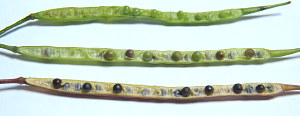 The top seed pod is full of green immature seed, which would be very weak & feeble once dried out if you picked it at this stage.
The top seed pod is full of green immature seed, which would be very weak & feeble once dried out if you picked it at this stage. - The middle seed pod is full of seed that have filled up as much as they are going to, and are just starting to go brown.
- The bottom pod is full of completely ripe seed, and the pod itself will very soon go dry & papery, splitting open and releasing its seed at the slightest touch.
So, one trick is to harvest the seed when most pods are like the middle one. They are as good as they will get, energetically speaking, and will ripen nice and brown once you cut the plant.
To decide when to harvest:
Just keep an eye on your plants, and periodically pick open a pod & look inside. You might notice that the stalks and pods change colour too in some varieties, but it is the seed-coat that is the foolproof indicator.
You'll probably also notice that the pods at the bottom of each flower spike ripen first, with the ones further up (later flowers) ripening later. Of course, you'll cut the whole lot at once, so you need to look at the pods in the middle and top too.
Usually if you judge by the seeds in the middle pods, you'll be ok - the ones at the bottom will be a bit riper, and the ones at the top a bit under-ripe, but this is the best compromise.
You'll need to check every couple of days as they get close to being ready. They can all ripen suddenly & fall out without warning if you're not careful. Also, small birds are very good at knowing when they are ready, too.
Harvest & Threshing
So, you've decided its time to harvest. Cut the whole stem off, and pile on an old sheet somewhere airy (and bird-free - they love the seed) to dry.
Remember you need to take seedheads from each plant - these are the plant equivalent of herd animals; they live in groups and you need seed from them all to avoid inbreeding. If you collected seed from just one or two plants, after a few seasons all your kale would be very poor.
Once dry, jump all over them and you'll get lots of seed mixed with broken up stem & pods. Shake it and the seeds will fall to the bottom - you can just pull off most of the pods now. Watch us doing it here:
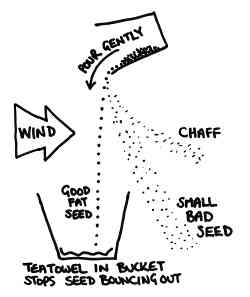 Winnowing
Winnowing
Then to get the rest out, pour the seed and bits from one bucket to another in a breeze - the bits will blow away, and the seed will remain. There is a whole page on this in our seedsaving pages, but it is pretty easy to follow the diagram.
Drying & Storage
This is a really important bit. You need to dry your seed out, or it will not keep. Seed that is air-dry is not really properly dormant - its just napping; so it is still burning through its stored reserves of energy and will soon run flat - like a mobile phone left on.
Also, you can't put it in a sealed container as it is still breathing - it would suffocate. And without a sealed container, it will soon reabsorb water from the air on the first humid day, and start getting ready to germinate.
We'll use dry rice to suck the water out of the seed & get it really dry. Then it will hibernate completely.
You need a big jam-jar, an old pair of tights, a rubber band, and some rice - at least twice as much rice as you have seed. It doesn't matter if you have too much rice, but too little won't work.
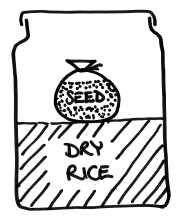 Bake the rice in the oven for 45 minutes until it is bone dry. While it is still hot, put it in the jam-jar , about half full, and screw the lid on .
Bake the rice in the oven for 45 minutes until it is bone dry. While it is still hot, put it in the jam-jar , about half full, and screw the lid on .
Wait patiently until the rice is cool. (If you rush this you'll cook your seeds.) So you now have a jam jar 1/2 full of very dry rice.
Put your seed in a bag made by cutting off the foot of the tights, and tie it in with a rubber band. Put it in with the cool dry rice. Put the lid on tightly, so damp air can't get in.
Leave your seed sealed in the jar with the dry rice for a fortnight, and the dampness in the seed will be drawn out into the rice.
You now have bone-dry seed that you can safely seal in a plastic bag, and it will keep for several years.
Passing it Round
This is also important. You will have huge amounts of seed. If you are sure you avoided crossing, and that your plants were nice and healthy, then you have a valuable thing there.
You will get about two and a half kilos of seed from a 20-foot-long bed of 30 plants. Now that's actually three-quarters of a million seeds - and if every one of those was given away or swapped, and then grown, you will have created more than 500,000 kilograms of kale! More than enough to feed all your friends and neighbours, and their families.
So you can see that even one person, on a small scale, can make a real contribution to local food security. Take your spare seed to a local seed swap, or even better, organise your own. Get to gether with your friends or family and set up a seed-circle: one person can grow kale seed, another parsnips, another cucumber, etc etc. You'll all have bags of seed - you can all just swap with each other, so no-one has to save seed from more than a couple of things, yet you all get seed of everything.
It will save you a fortune, and you'll get great, locally-adapted varieties. Just remember, all this is only possible because you are growing real, open-pollinated seed. You can't do this with hybrid (F1) varieties. Funny how the seed companies are so keen on selling you hybrid seed, isn't it?





